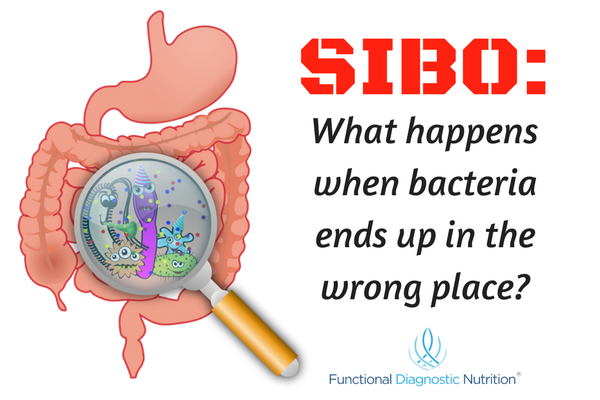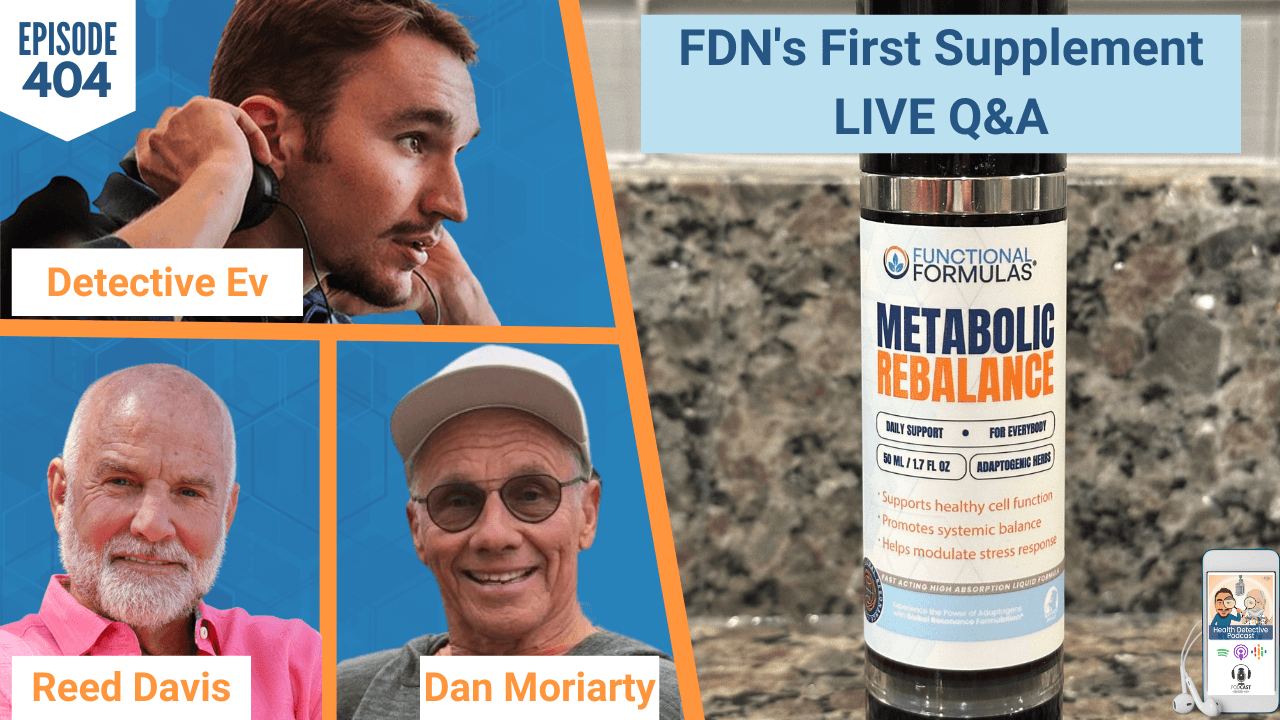Do you have a client with chronic gas, bloating or abdominal cramps? These symptoms, and more, can be a sign of bacterial overgrowth in the small intestine. SIBO may be the cause!
As a health coach, you’re probably aware the gut should be populated with a healthy ratio of friendly bacteria.
And because of the soaring popularity of probiotic supplements and foods containing microflora such as yogurt, kefir and sauerkraut, it’s not just health coaches who are becoming more knowledgeable about the role the microbiome plays in overall health.
But the question few people can answer is, where should most gut bacteria reside?
The answer: not in the small intestine.
In fact, relatively few bacteria normally live in the small intestine. There are 10,000 bacteria per milliliter of fluid that live in the large intestine. Compared to that only 100 bacteria per milliliter of fluid colonize the small intestine.
In other words, in a healthy person, there should be 100 times more bacteria in the large intestine than in the small intestine.
However, some people have a condition called “SIBO.” And if one of your clients has SIBO, they may present with symptoms that don’t make for pleasant dinner conversation: gas, belching, bloating, constipation, and diarrhea.
What is SIBO?
SIBO, or small intestinal bacterial overgrowth, is when too many bacteria colonize the small intestine. And we’re not talking about a bloom of harmful, pathogenic bacteria. On the contrary, SIBO is an overgrowth of normal bacteria, but in the wrong place. In some cases, bacteria from the oral cavity can migrate into the small intestine. However, SIBO is mostly indicative of bacteria from the large intestine migrating into the small intestine.
In the right place, bacteria is very beneficial. For example, in the large intestine, bacteria aid in the production of vitamins and short chain fatty acids. On the other hand, in the small intestine, too many bacteria may be detrimental to health.
In fact, SIBO may be the underlying cause of your client’s digestive problems or chronic pain and inflammation. And if you have a client that hasn’t improved despite diet modification, following our health-rebuilding D.R.E.S.S. protocol (Diet, Rest, Exercise, Stress Reduction, Supplements), and not showing any positive indicators on a GI pathogen stool test, SIBO may be to blame.
How do you know if it’s SIBO?
In addition to the symptoms above, SIBO is responsible for several other common signs of systemic imbalance, including:
- Abdominal pain/cramps
- Nausea
- Heartburn
- Acid reflux
- Skin issues (rosacea, eczema)
- Food sensitivities
- Anemia and malnutrition
Also, if one of your clients frequently complains about headaches, fatigue, irritability or joint pain, SIBO could be the culprit.
What causes SIBO?
Our advanced SIBO online course will teach you everything you need to know about how to solve your client’s health problems that may be attributable to an overgrowth of bacteria in the small intestine. But here’s a sneak peek at why SIBO occurs in the first place….
One main contributing factor of excess bacteria in the small intestine is insufficient MMC, or Migrating Motor Complex. Think of MMC as your small intestine’s diligent janitor with an incredible work ethic. The MMC “sweeps” and moves bacteria and debris down into the large intestine. This MMC action occurs in between meals and during fasting at night. This MMC action prevents bacteria from colonizing in the small intestine. In fact, this sweeping occurs every 90-120 minutes between meals. In a healthy person, the small intestine is swept away of bacteria 11 times a day.
But if one of your clients has an excess of microflora in the small intestine, the MMC action occurs only three times daily. Thus, if you have a client who is a grazer and eats several small meals a day and presents with “pregnant belly” or one of the other symptoms above, it might be time to suggest eating less often.
Unfortunately, only 3 centers in the U.S. as of this writing offer a test for MMC function. In addition to eating too frequently, other factors can negatively impact MMC function:
- Diabetes
- GI dysfunction
- Surgery
- High histamine levels
[How can you know for sure all your clients are getting a clean sweep of their small intestine? Register here for our advanced training course on SIBO.]
More causes of SIBO
Do you have a client who in the past traveled to an exotic destination, particularly a developing country? Perhaps your client, partaking in their own version of Eat, Pray, Love, was struck with food poisoning in India or Indonesia. Or even worse, amoebic dysentery.
Food poisoning, or traveler’s diarrhea can interfere with MMC sweeping action. In addition, certain pathogenic bacteria such as salmonella, e. Coli, and C. Difficile can weaken MMC activity. These pathogenic bacteria secrete a toxin that looks like a protein normally found on small intestine nerve cells. Normally, these cells act as an electrical pacemaker for MMC action. However, the immune system not only attacks the toxic bacteria but also the nerve cells. The nerve cells undergo damage and thus prevent proper MMC activity.
How SIBO can impact health
When there’s too much bacteria in the small intestine, digestion suffers. That’s because the bacteria break apart sugars and carbohydrates along the lining of the small intestine. As a result, if you have a client with SIBO, they can’t properly digest carbs. Moreover, your client could suffer from nutritional deficiencies. After all, these microscopic critters are stealing your client’s food!
In addition, SIBO may cause poor fat absorption. As a consequence of the overpopulation of bacteria, deconjugated bile leads to diminished bioavailability of fat-soluble nutrients (such as vitamins A & D). In turn, this may result in fatty stools.
Similar to collagen proteins protecting the joints, the lining of the small intestine contains a protein called zonulin. Unfortunately, small intestinal bacterial overgrowth damages this protein. The damage of this protein is a contributing factor to leaky gut or increased intestinal permeability.
SIBO damages the microscopic hairs in the intestinal tract, known as villi. Once the villi are damaged it leads to poor nutrient absorption. And the domino effect continues as the poor brush border negatively affects digestion, which, in turn can leads to food intolerance. But the intestinal dysfunction doesn’t stop there. Food enzyme deficiency occurs. And then, the immune system starts attacking food particles in the bloodstream as if they were pathogenic toxins. Autoimmune disease lurks just around the corner….
In short, the overgrowth of bacteria in the small intestine excretes acids. And too many of these acids can result in neurological dysfunction.
SIBO: What you’ll learn and how you’ll help your clients
By now, you should have a good understanding that too many bacteria in the small intestine can be detrimental to your client’s well-being. It’s more than likely you’ll have several clients presenting with chronic bloating, abdominal distention, gas, and other symptoms caused by an excess of microscopic critters in the small intestine. So how can you help your clients overcome the effects of SIBO?
FDN is offering an advanced SIBO course, where you get to the heart of what SIBO is and how you can help clients who are struggling with it. In the course you’ll learn the three main gases produced by SIBO bacteria, why it occurs, what causes it, and the symptoms you can expect to see when a client presents with SIBO.
Also, you will learn when to consider recommending testing for SIBO and which tests to use to determine if SIBO is present. In addition, we’ll go over numerous examples of SIBO test reports. And we’ll teach you how to interpret the test results. Moreover, to help your clients with SIBO get better, we’ll discuss various treatments. Finally, we’ll address SIBO retest protocols and help you identify your clients who are at greater risk of developing SIBO or having a relapse after initial treatment.
Ready to help your clients and distinguish yourself from other health experts? Become a SIBO expert.







